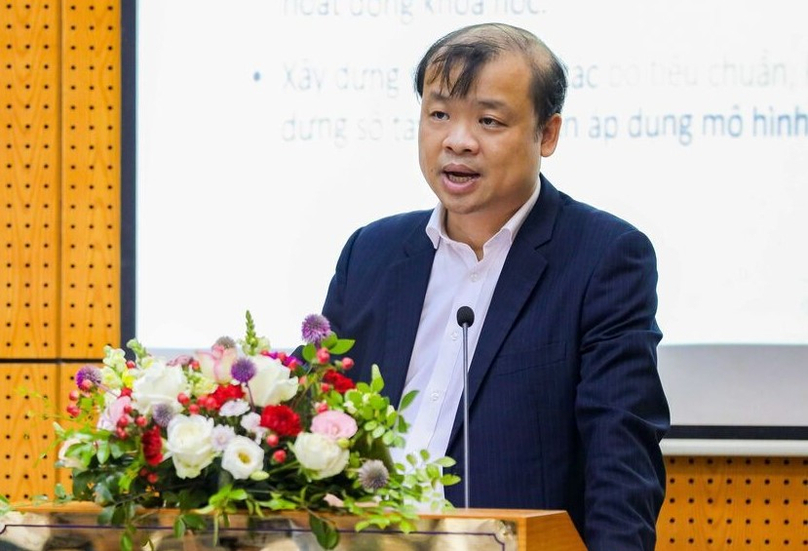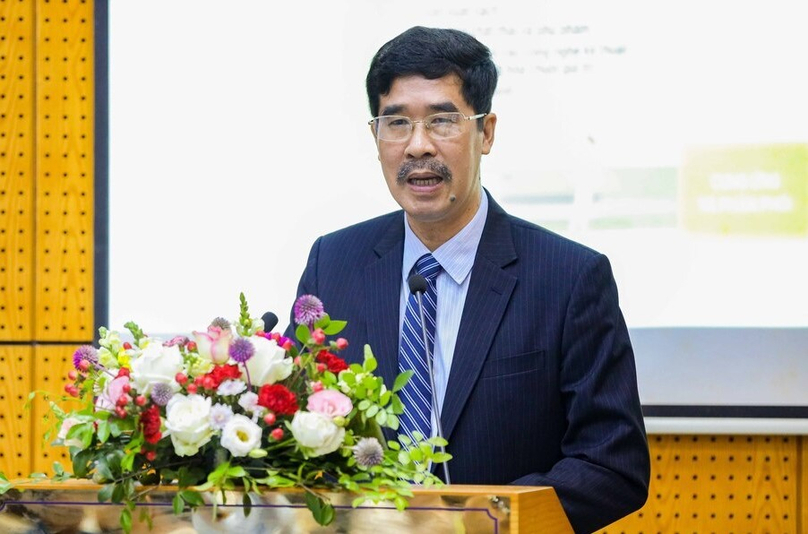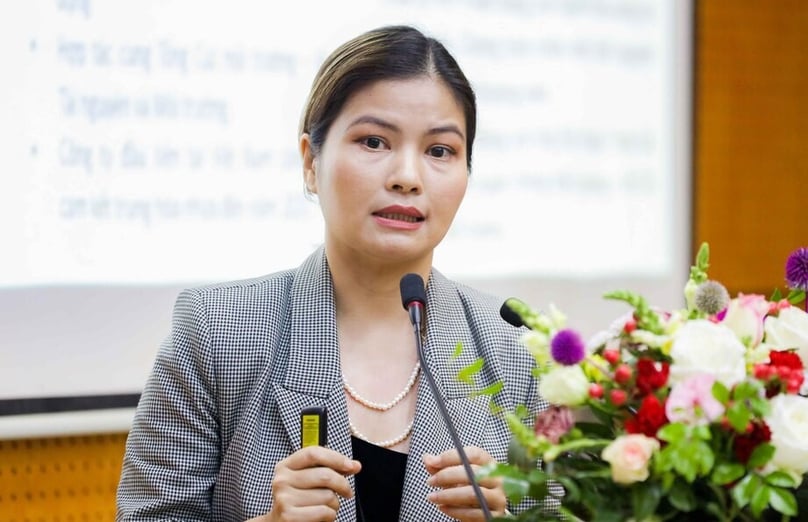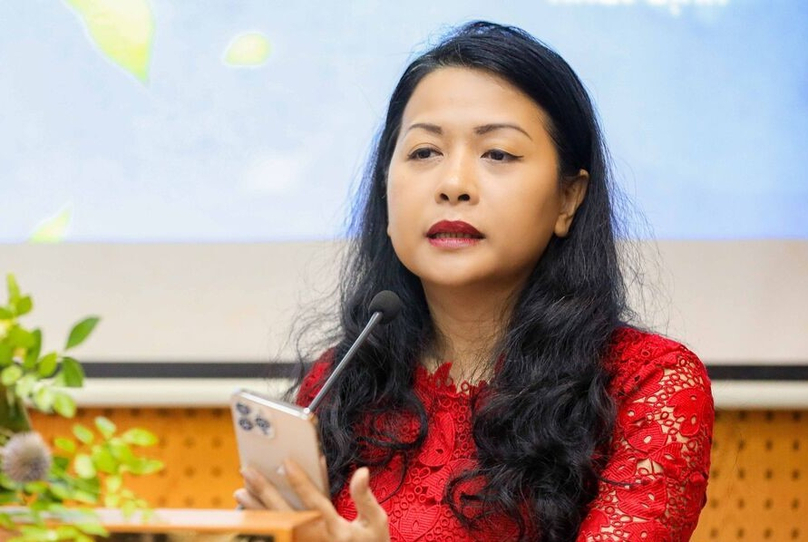Triple helix collaboration crucial for circular economy growth: expert
Developing a circular economy in Vietnam requires concerted interactions between the government, enterprises, and relevant stakeholders, a Central Institute for Economic Management (CIEM) economist said Wednesday.
CIEM deputy chief Nguyen Hoa Cuong made the recommendation at a workshop held by The Investor in Hanoi to promote circular economy development in the country, one of the world’s fastest expanding economies, which is seeking to champion sustainable development.
His other suggestions are for both policymakers and enterprises to foster circular economy development.

Nguyen Hoa Cuong, deputy chief of the Central Institute for Economic Management. Photo by The Investor/Trung Hieu.
For the first group, it is necessary to increase public awareness of the circular economy and circular business models, and build policies to support the whole process.
“The state role should include building a legal framework for this, focusing on regulations to promote circular business-based enterprises, and the models should well fit the reality and market needs,” Cuong said.
Science and technology have to play an important role to support businesses in pursuit of circular business models, he noted, adding that the government, enterprises, and relevant stakeholders should join efforts in exploring the progress of science and technology to drive the process.
As for businesses, the CIEM deputy head said they should give priority to green products and products from circular business models, meaning the goods favored by those markets. “It is also advisable for enterprises to enhance business networking and join supply chains both domestically and overseas to be able to create synergy via such cooperation.”

A Vinamilk farm in Quang Ngai province, central Vietnam with a rooftop solar power system.
Corporate pioneers
Vinamilk, Vietnam’s largest dairy company, has already shifted to a circular business model, Vinamilk R&D director Nguyen Quoc Khanh, told the event. “The model includes reducing waste, reusing and recycling resources and products,” he said, calling it the 3Rs.

Vinamilk R&D Director Nguyen Quoc Khanh at the workshop. Photo by The Investor/Trung Hieu.
Vinamilk also conducts sustainable cattle farming and clean production, minimizing waste while maximizing its value chain. In distribution, the major makes use of artificial intelligence to cut costs and power consumption.
In waste management, Khanh said Vinamilk seeks to minimize adverse impacts on the environment and effectively use resources. All waste is classified and treated by professional contractors, while 100% of wastewater from factories is treated subject to regulated standards before being discharged.
The corporation has built biogas systems at its farms to minimize greenhouse emissions. Meanwhile, renewable energy from biogas systems is reused to heat water, he said.
Vinamilk also turns cow dung into fertilizer, waste sludge into farming soil, makes sure its dairy cows contain no growth hormones, and assures grass is free from GMOs (genetically modified organisms).
For Nestle Vietnam, Le Hoai Thuong, senior corporate affairs manager at the Swiss-backed company, said her firm is aiming at a net-zero goal by 2025 by using renewable energy and eco-friendly means of transport. “100% of product packaging could be recycled or reused by 2025,” she said.

Le Thi Hoai Thuong, senior corporate affairs manager, Nestle Vietnam. Photo by The Investor/Trung Hieu.
Thuong added her company has reduced the use of primary plastic in production, applied a circular business model in waste management to ensure 100% of coffee grounds are recycled into biomass fuel. Waste sand from boilers continues to be recycled into unburnt bricks, and waste sludge is recycled into organic fertilizers.
In coffee farming, under a Nestle Vietnam roadmap, the company has supported its contracted farmers in responsibly growing trees based on a regenerative agriculture model, in order to obtain the goal of water neutrality by 2025 through saving and regenerating water resources.
“We are fully aware that we must be responsible for our products, must partner with many suppliers in using recycled plastic and reducing virgin plastic in packaging. Consumers should support a circular business model so that Vietnam can promote a circular economy,” she added.
Like Nestle, Vietnamese beverage producer Tan Hiep Phat has embraced a circular business model, said Tran Uyen Phuong, its deputy CEO.

Tan Hiep Phat deputy CEO Tran Uyen Phuong. Photo by The Investor/Trung Hieu.
“We’ve used world-leading technology to meet requirements for a circular economy, including maximizing economic efficiency,” she said.
The producer uses advanced technologies for plastics washing, extruder, and injection molding to recycle PE and PP plastic for pallet production, and garbage containers, and has an automatic digitized management system from production to supply, according to Phuong.
The company’s 3Rs model has helped Tan Hiep Phat reduce more than 70,000 tons of plastics used from 2013-2022, while it seeks to increase the result to 112,000 tons by 2027, she said.
- Read More
Viettel Commerce partners with China’s Dreame Technology to expand home appliance ecosystem in Vietnam
Viettel Commerce and Import-Export Co. Ltd., one of the core pillars in trade and logistics of the military-run telecom giant Viettel, has signed a strategic cooperation agreement with China-based Dreame Technology, a global high-end technology brand, in Hanoi.
Companies - Tue, December 23, 2025 | 3:38 pm GMT+7
Former LPBank chairman becomes acting Sacombank CEO
Former chairman of Vietnamese private lender LPBank Nguyen Duc Thuy on Tuesday assumed the role of acting CEO at Sacombank, immediately after completing the handover at LPBank.
Banking - Tue, December 23, 2025 | 3:30 pm GMT+7
Workforce shortages accelerate global demand for integrated facility management
Labor shortages and rising expectations for operational performance are prompting many businesses to reassess traditional management models, write Savills Vietnam analysts.
Consulting - Tue, December 23, 2025 | 3:00 pm GMT+7
Property broker Cen Land shares stabilize after ‘Shark Hung’ responds to online rumors
Shares of Cen Land (HoSE: CRE), a major Vietnamese real estate brokerage, stabilized on Tuesday morning after vice chairman Pham Thanh Hung, widely known as “Shark Hung”, spoke out to deny online rumors following a sharp sell-off in the stock on Monday.
Companies - Tue, December 23, 2025 | 11:59 am GMT+7
Party Central Committee’s 15th plenum wraps up
The 15th plenum of the 13th Party Central Committee concluded on Tuesday morning after two days of intensive working, completing all agenda items with a high degree of consensus and quality.
Politics - Tue, December 23, 2025 | 11:50 am GMT+7
Steel giant Hoa Sen sets up subsidiary in northern Vietnam
Hoa Sen Group (HoSE: HSG), one of Vietnam’s largest steel producers, has disclosed a board resolution approving the establishment of Hoa Sen Hai Phong One Member Limited Liabilities Company (HSHP), a wholly-owned subsidiary with charter capital of VND300 billion ($11.39 million).
Companies - Tue, December 23, 2025 | 11:31 am GMT+7
UOB's latest USD/VND projections for 2026 are 26,300 in Q1, 26,100 in Q2
Analysts at Singaporean bank UOB say they maintain a cautious stance on the Vietnamese dong (VND) and their updated USD/VND forecasts for next year are at 26,300 in Q1, 26,100 in Q2, 26,000 in Q3, and 25,900 in Q4.
Banking - Tue, December 23, 2025 | 10:07 am GMT+7
Vietnam's major food maker Kido delays 2024 dividend payout due to economic headwinds
Kido Group has postponed its planned cash dividend payment for 2024, citing persistent economic difficulties and the need to preserve cash flow for operations in late 2025 and early 2026.
Companies - Tue, December 23, 2025 | 8:00 am GMT+7
Petrovietnam chairman Le Manh Hung appointed acting Industry and Trade Minister
Prime Minister Pham Minh Chinh has appointed Le Manh Hung, chairman of the council of members at state-owned Petrovietnam (PVN), as acting Minister of Industry and Trade.
Politics - Mon, December 22, 2025 | 9:55 pm GMT+7
Vietnam's top non-life insurer PVI surpasses $1 bln in revenue
PVI Insurance, a leading non-life insurer in Vietnam, has surpassed $1 billion in revenue, becoming the first non-life insurance company in the country to reach this revenue scale.
Companies - Mon, December 22, 2025 | 7:30 pm GMT+7
JC&C completes sale of 4.6% Vinamilk stake to F&N for $228 mln
Singapore-listed Jardine Cycle & Carriage Limited (JC&C) has reportedly completed the sale of more than 96 million shares, equivalent to a 4.6% stake, in Vietnam’s dairy giant Vinamilk (HoSE: VNM).
Companies - Mon, December 22, 2025 | 6:50 pm GMT+7
Shares linked to ‘Shark Hung’ slide despite market rallies
Shares of Cen Land (HoSE: CRE), a major Vietnamese real estate brokerage linked to businessman Pham Thanh Hung, fell sharply on Monday, bucking a broad market rally that lifted the benchmark VN-Index to a fresh high.
Companies - Mon, December 22, 2025 | 4:17 pm GMT+7
Intel urged to expand chip packaging, testing operations in Vietnam
Vietnam has urged Intel to step up investment in semiconductor packaging and testing operations in the country, as Hanoi accelerates efforts to build a domestic chip ecosystem aligned with global supply chains.
Investing - Mon, December 22, 2025 | 3:37 pm GMT+7
Korean energy giant LS intends to inject $19.3 mln into Vietnam rare earth business
LS Eco Energy, a subsidiary of South Korea’s cable and energy giant LS Cable & System, has decided to invest KRW28.5 billion ($19.26 million) in advancing its rare earth metals business in Vietnam.
Industries - Mon, December 22, 2025 | 3:11 pm GMT+7
Vietnam's Petrosetco estimates 2025 net profit rises 46% to over $12 mln
PetroVietnam General Services Corporation (Petrosetco) expects its net profit to reach VD322 billion ($12.23 million) in 2025, up 46% year-on-year and exceeding the company's full-year target by 32%.
Companies - Mon, December 22, 2025 | 11:50 am GMT+7
Vietnam's 13th Party Central Committee convenes 15th meeting
The 15th meeting of Vietnam's 13th Party Central Committee opened in Hanoi on Monday.
Politics - Mon, December 22, 2025 | 11:13 am GMT+7


























